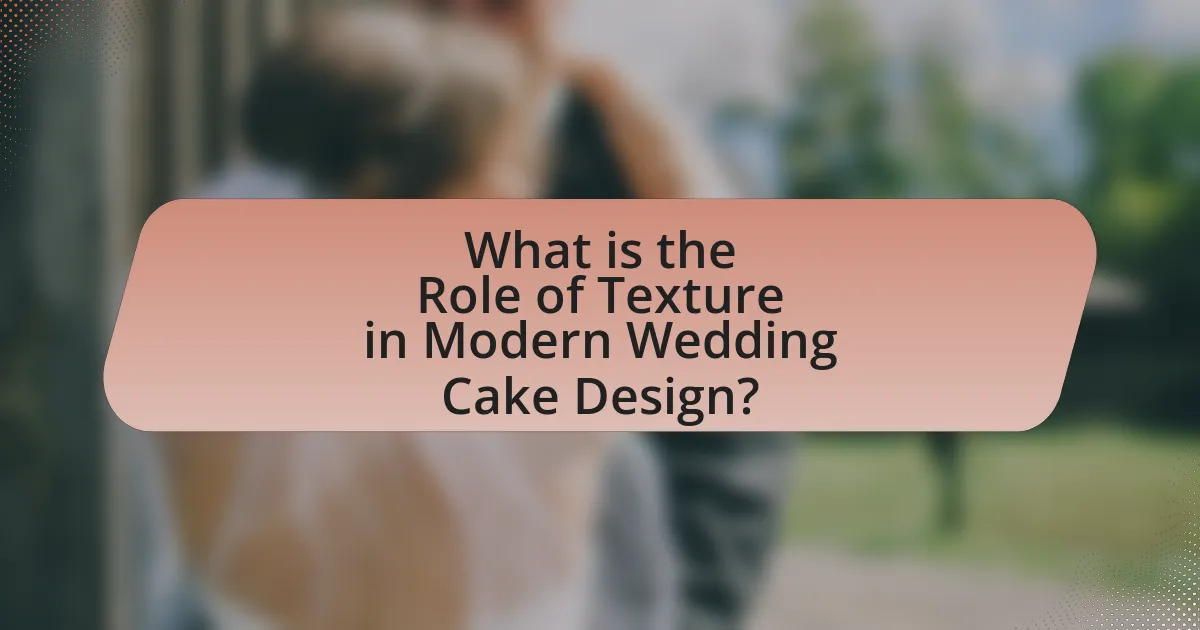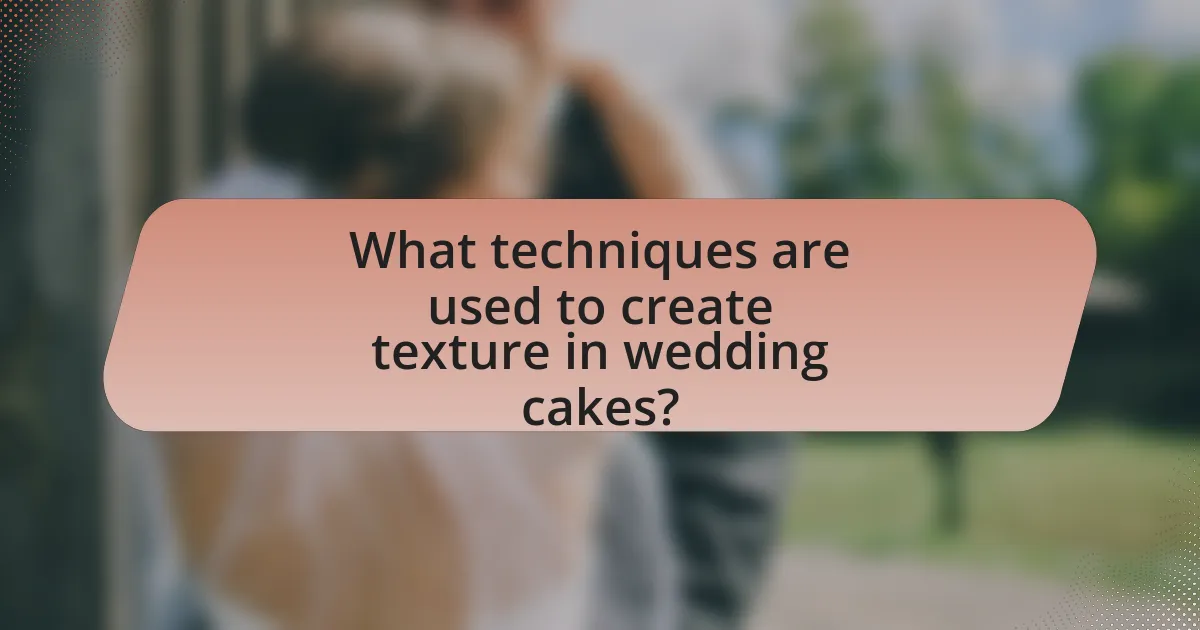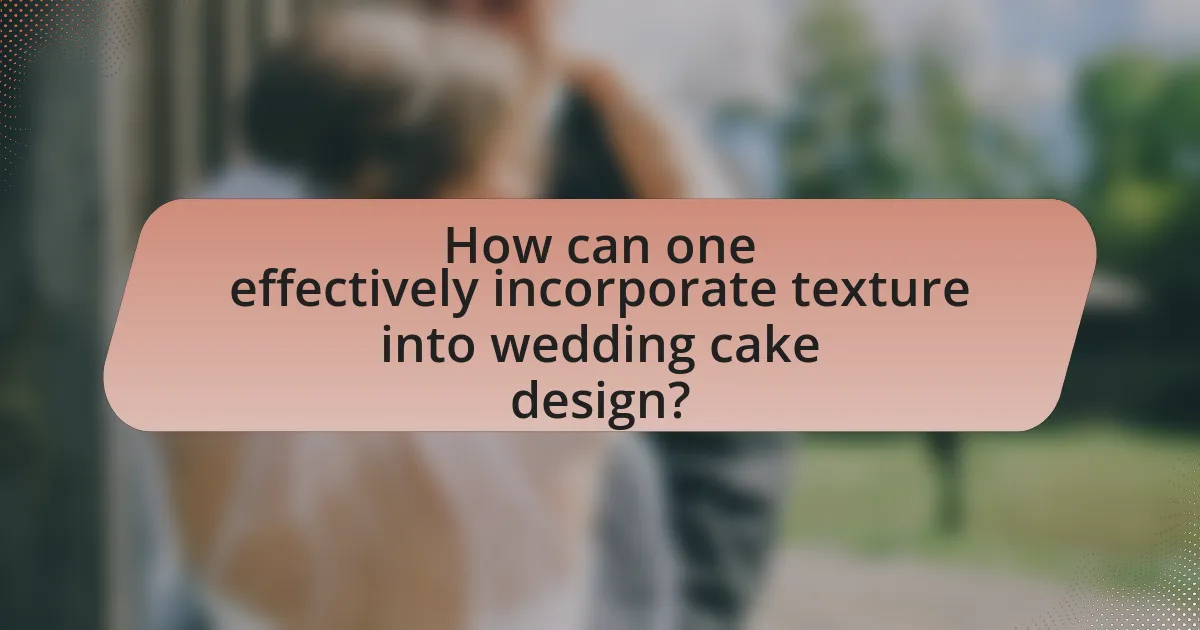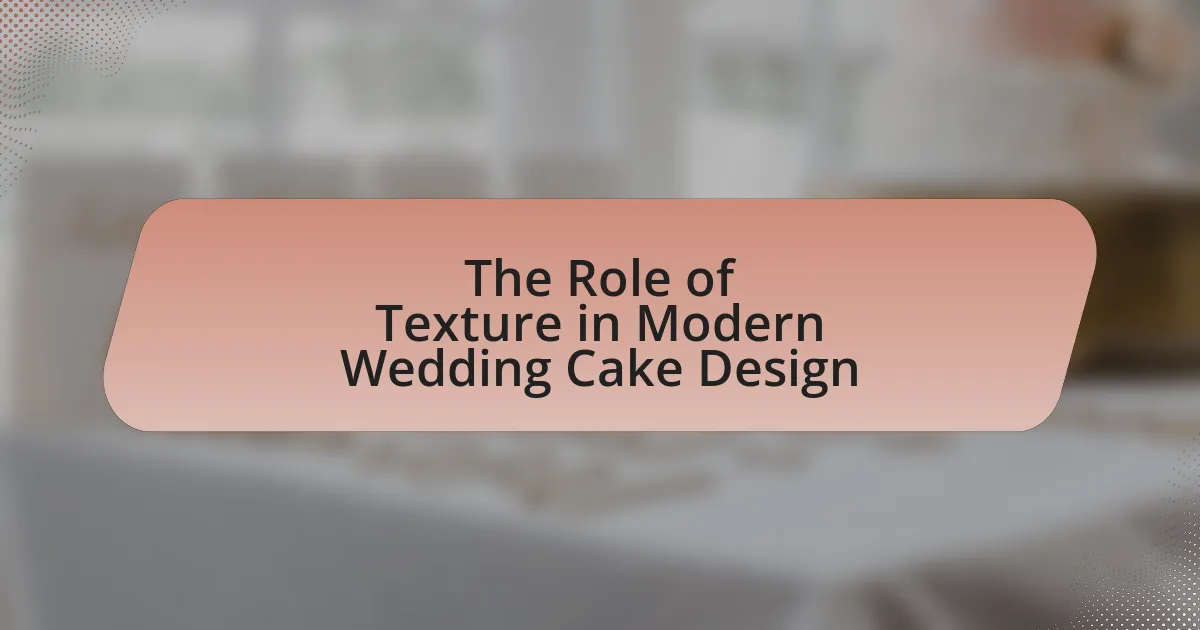The article focuses on the significant role of texture in modern wedding cake design, highlighting how various textural elements enhance visual appeal and create a multi-sensory experience. It discusses different types of textures, such as smooth fondant, ruffled buttercream, and intricate lace patterns, and their influence on the overall aesthetic and theme of wedding cakes. The article also explores current trends, innovative techniques, and practical considerations for bakers when incorporating texture into cake designs, emphasizing the importance of texture in flavor perception and guest engagement. Additionally, it provides guidance for couples on how to communicate their texture preferences effectively to bakers.

What is the Role of Texture in Modern Wedding Cake Design?
Texture plays a crucial role in modern wedding cake design by enhancing visual appeal and creating a multi-sensory experience. The incorporation of various textures, such as smooth fondant, ruffled buttercream, or intricate lace patterns, allows cake designers to add depth and dimension, making the cake more visually striking. Textural elements can also evoke specific themes or emotions, aligning with the couple’s wedding aesthetic. For instance, a rustic wedding cake may feature a rough, natural texture to complement a countryside setting, while a sleek, modern cake might utilize a high-gloss finish to convey elegance. This strategic use of texture not only elevates the cake’s design but also engages guests, making the cake a focal point of the celebration.
How does texture influence the overall aesthetic of wedding cakes?
Texture significantly influences the overall aesthetic of wedding cakes by adding depth and visual interest. The interplay of smooth, rough, or intricate textures can enhance the cake’s design, making it more visually appealing and engaging. For instance, a cake with a combination of smooth fondant and textured buttercream can create a striking contrast that draws attention. Additionally, textured elements like ruffles or lace patterns can evoke specific themes or styles, such as vintage or modern elegance, thereby aligning the cake’s appearance with the couple’s wedding theme. Studies in culinary arts highlight that texture not only affects visual appeal but also impacts perceived taste, as varied textures can create a more dynamic eating experience, further enhancing the cake’s overall aesthetic value.
What are the different types of textures used in wedding cake design?
Different types of textures used in wedding cake design include smooth, ruffled, quilted, and lace textures. Smooth textures are achieved through fondant or buttercream, providing a sleek appearance. Ruffled textures involve layers of icing or fondant that create a soft, romantic look. Quilted textures feature a diamond pattern, often achieved with a quilting tool, adding elegance. Lace textures mimic intricate lace designs, often made with edible lace or piping techniques, enhancing the cake’s sophistication. Each texture contributes to the overall aesthetic and theme of the wedding cake, allowing for personalization and creativity in design.
How do textures enhance the visual appeal of wedding cakes?
Textures enhance the visual appeal of wedding cakes by adding depth and dimension, making them more visually interesting. The use of various textures, such as smooth fondant, ruffled buttercream, or intricate lace patterns, creates contrast that draws the eye and elevates the overall design. For instance, a cake with a combination of glossy and matte finishes can create a striking visual effect, while textured elements like sugar flowers or piped details can add a tactile quality that invites closer inspection. This interplay of textures not only enhances aesthetic appeal but also allows for personalization, reflecting the couple’s style and theme, which is crucial in modern wedding cake design.
Why is texture important in the context of wedding cake themes?
Texture is important in the context of wedding cake themes because it enhances visual appeal and contributes to the overall sensory experience. The interplay of different textures, such as smooth fondant, rustic buttercream, or intricate lace designs, can evoke specific themes and emotions, making the cake a focal point of the celebration. For instance, a textured cake can reflect the couple’s personality or the wedding’s aesthetic, such as a vintage theme with ruffled icing or a modern look with geometric patterns. Studies in culinary arts indicate that texture influences taste perception, suggesting that a well-textured cake can enhance the enjoyment of flavors, thereby reinforcing the significance of texture in wedding cake design.
How does texture complement various wedding themes and styles?
Texture enhances various wedding themes and styles by adding depth, visual interest, and tactile appeal to cake designs. For instance, a rustic wedding theme benefits from rough, natural textures like bark or fondant that mimics wood, creating an organic feel. In contrast, a modern minimalist theme often utilizes smooth, sleek textures that convey elegance and simplicity, such as fondant or ganache. Additionally, a vintage theme can incorporate intricate lace patterns or ruffles, evoking nostalgia and romance. These textural elements not only align with the overall aesthetic of the wedding but also engage guests’ senses, making the cake a focal point of the celebration.
What role does texture play in creating a cohesive wedding cake design?
Texture plays a crucial role in creating a cohesive wedding cake design by enhancing visual interest and depth. Different textures, such as smooth fondant, ruffled buttercream, or intricate lace patterns, can complement each other and contribute to an overall harmonious appearance. For instance, a cake featuring both a smooth finish and textured elements can create a dynamic contrast that draws the eye, making the design more engaging. Additionally, texture can evoke specific themes or emotions; for example, rustic textures may convey warmth and intimacy, while sleek finishes can suggest elegance and sophistication. This interplay of textures not only unifies the cake’s aesthetic but also aligns it with the overall wedding theme, ensuring that it resonates with the couple’s vision and the event’s atmosphere.
What are the current trends in texture for modern wedding cakes?
Current trends in texture for modern wedding cakes include the use of smooth finishes, textured buttercream, and intricate fondant designs. Smooth finishes, often achieved with ganache or fondant, create a sleek and elegant appearance that is popular among contemporary couples. Textured buttercream, featuring techniques like ruffles or swirls, adds a rustic yet sophisticated touch, appealing to those who favor a more organic aesthetic. Additionally, intricate fondant designs, such as lace patterns or 3D floral elements, are increasingly favored for their ability to create visually stunning and detailed cakes. These trends reflect a shift towards personalization and artistry in wedding cake design, catering to diverse tastes and styles.
How have texture trends evolved in recent years?
Texture trends in wedding cake design have evolved towards a greater emphasis on natural, organic finishes and intricate detailing. In recent years, bakers have shifted from smooth, fondant-covered cakes to more textured surfaces, such as buttercream with visible strokes, ruffles, and floral patterns. This change reflects a broader trend in the culinary arts that values authenticity and artisanal craftsmanship. For instance, a survey by The Knot in 2022 indicated that 60% of couples preferred cakes with unique textures over traditional smooth finishes, highlighting a significant shift in consumer preferences.
What innovative techniques are being used to create unique textures?
Innovative techniques used to create unique textures in modern wedding cake design include airbrushing, fondant manipulation, and the use of edible materials like isomalt and chocolate. Airbrushing allows for gradient effects and intricate patterns, enhancing visual depth. Fondant manipulation techniques, such as ruffling and draping, create dynamic surfaces that mimic fabric or natural elements. Additionally, isomalt can be molded into delicate shapes, while chocolate can be sculpted or tempered to achieve varied textures. These methods have been increasingly adopted by cake designers to elevate the aesthetic appeal and tactile experience of wedding cakes.
How does texture affect the taste and experience of wedding cakes?
Texture significantly influences the taste and overall experience of wedding cakes by affecting mouthfeel and flavor perception. A cake’s texture, whether it is moist, crumbly, dense, or airy, directly impacts how flavors are released and experienced on the palate. For instance, a moist cake tends to enhance sweetness and richness, while a drier texture may lead to a less enjoyable experience as flavors can become muted. Additionally, contrasting textures, such as a smooth frosting paired with a fluffy cake, create a more dynamic eating experience, engaging multiple sensory receptors. Studies in food science indicate that texture can alter flavor perception; for example, research published in the journal “Food Quality and Preference” demonstrates that texture variations can significantly change how flavors are perceived, thus reinforcing the importance of texture in cake design.
What practical considerations should be taken into account when designing textured wedding cakes?
When designing textured wedding cakes, bakers should consider structural integrity, flavor compatibility, and aesthetic coherence. Structural integrity is crucial as textured elements can affect the cake’s stability; for instance, heavier textures may require additional support to prevent collapsing. Flavor compatibility is important because certain textures, like fondant or ganache, can alter the taste experience; thus, pairing textures with complementary flavors enhances overall enjoyment. Aesthetic coherence ensures that the texture aligns with the wedding theme and color palette, creating a harmonious visual appeal. These considerations are essential for achieving a successful and appealing wedding cake design.

What techniques are used to create texture in wedding cakes?
Techniques used to create texture in wedding cakes include fondant draping, ruffling, and the use of various piping methods. Fondant draping allows for smooth, elegant layers that can be manipulated to create soft folds, while ruffling adds a romantic, whimsical touch. Piping techniques, such as rosettes or lace patterns, enhance visual interest and depth. These methods are widely recognized in cake design, as they contribute to the overall aesthetic and tactile experience of the cake, making it visually appealing and memorable for the occasion.
How can bakers achieve different textures in cake layers?
Bakers can achieve different textures in cake layers by varying ingredients, mixing methods, and baking techniques. For instance, using different types of flour, such as cake flour for a tender crumb or all-purpose flour for a denser texture, directly influences the final outcome. Additionally, incorporating fats like butter or oil can create moistness, while the creaming method introduces air for a lighter texture. Adjusting the mixing time also affects texture; overmixing can lead to toughness, while undermixing can result in a crumbly cake. Furthermore, baking at different temperatures can yield varied crusts, with higher temperatures creating a crisp exterior and lower temperatures promoting even baking. These methods are supported by culinary science, which shows that ingredient composition and preparation techniques significantly impact cake texture.
What methods are used to create smooth versus rough textures?
Smooth textures in cake design are typically achieved through methods such as fondant covering, buttercream smoothing, and ganache glazing. Fondant creates a sleek surface by rolling out a thin layer that adheres to the cake, while buttercream can be smoothed using a spatula or bench scraper to eliminate imperfections. Ganache, when poured over a cake, provides a glossy finish that hardens to a smooth surface.
In contrast, rough textures are created using techniques like textured buttercream, piped decorations, and the use of edible materials such as sugar crystals or chocolate shavings. Textured buttercream can be applied with a palette knife or a piping bag to create peaks and valleys, while piped decorations add dimension and visual interest. Edible materials can be sprinkled or layered to enhance the roughness of the cake’s surface.
These methods are widely recognized in the cake decorating community, with fondant and ganache being staples for achieving smooth finishes, while textured buttercream and decorative elements are commonly used for rough textures.
How do fillings and frostings contribute to the overall texture?
Fillings and frostings significantly enhance the overall texture of cakes by adding layers of creaminess, moisture, and contrast. Fillings, such as fruit preserves or ganache, introduce a soft, often fruity or rich element that complements the cake’s crumb, while frostings, like buttercream or fondant, provide a smooth, sweet coating that can be either light and airy or dense and creamy. This combination creates a multi-dimensional mouthfeel, making each bite more enjoyable. For instance, a cake with a rich chocolate ganache filling paired with a light vanilla buttercream frosting offers a balance of textures that enhances the overall eating experience.
What decorative techniques enhance the texture of wedding cakes?
Decorative techniques that enhance the texture of wedding cakes include fondant smoothing, ruffling, and the use of edible lace. Fondant smoothing creates a sleek surface that can be further enhanced with texture tools to add dimension. Ruffling, achieved through piping techniques, introduces a soft, romantic feel, while edible lace adds intricate patterns that create visual interest and depth. These techniques are widely used in modern cake design to elevate the aesthetic appeal and tactile experience of wedding cakes.
How do fondant and ganache differ in texture application?
Fondant and ganache differ significantly in texture application; fondant provides a smooth, pliable surface ideal for creating a polished finish on cakes, while ganache offers a rich, creamy texture that can be used for draping or as a filling. Fondant is rolled out and applied to cakes, creating a sleek appearance, whereas ganache, made from chocolate and cream, can be poured or spread, resulting in a more organic, less uniform look. The contrasting textures influence the overall aesthetic and mouthfeel of wedding cakes, with fondant often used for intricate designs and ganache for a more rustic or decadent presentation.
What role do edible decorations play in adding texture?
Edible decorations play a crucial role in adding texture to wedding cakes by providing visual and tactile contrast. These decorations, such as fondant, chocolate shavings, or edible flowers, enhance the overall sensory experience of the cake, making it more appealing to both the eyes and the palate. For instance, a cake adorned with crisp sugar decorations can create a delightful crunch that complements the softness of the cake layers, thereby enriching the texture profile. This interplay of textures not only elevates the aesthetic quality of the cake but also contributes to a more dynamic eating experience, as supported by culinary studies that emphasize the importance of texture in food enjoyment.
What tools and materials are essential for creating textured wedding cakes?
Essential tools and materials for creating textured wedding cakes include a variety of cake decorating tools, specific types of icing, and texturing techniques. Key tools are offset spatulas for smoothing, bench scrapers for creating straight edges, and various piping tips for intricate designs. Materials such as fondant, buttercream, and ganache are crucial for achieving different textures. Additionally, tools like silicone molds and texture mats can help create patterns and designs on the cake surface. The use of these tools and materials allows bakers to produce visually appealing and unique textured wedding cakes, enhancing their overall aesthetic and appeal.
Which tools are best for achieving specific textures?
The best tools for achieving specific textures in modern wedding cake design include fondant smoothers, texture mats, and piping bags with various tips. Fondant smoothers are essential for creating a sleek, polished surface on cakes, while texture mats can imprint intricate designs onto fondant or buttercream, allowing for a variety of patterns. Piping bags equipped with different tips enable decorators to create detailed textures such as ruffles, shells, or lace effects. These tools are widely used in the industry, as evidenced by their prevalence in professional cake decorating courses and competitions, highlighting their effectiveness in achieving desired textures.
What materials are commonly used to enhance texture in cake design?
Common materials used to enhance texture in cake design include fondant, buttercream, ganache, and edible decorations like sprinkles and sugar flowers. Fondant provides a smooth, polished finish, while buttercream can be piped into various textures and patterns. Ganache adds a glossy, rich layer that can also be textured when whipped. Edible decorations, such as sprinkles or textured sugar pieces, contribute additional visual and tactile elements, making the cake more appealing. These materials are widely recognized in the baking industry for their ability to create diverse textures that elevate the overall aesthetic of cake designs.

How can one effectively incorporate texture into wedding cake design?
To effectively incorporate texture into wedding cake design, one can utilize various techniques such as fondant draping, ruffles, and the use of textured molds. These methods create visual interest and depth, enhancing the overall aesthetic of the cake. For instance, fondant draping can mimic the look of fabric, while ruffles add a romantic and whimsical touch. Textured molds can imprint intricate patterns onto the cake surface, providing a sophisticated finish. According to a study by the Cake Decorators Guild, cakes with varied textures are perceived as more appealing, leading to increased customer satisfaction and sales.
What tips can help bakers choose the right textures for their cakes?
Bakers can choose the right textures for their cakes by considering the desired flavor profile, moisture content, and structural integrity. For instance, a light and airy texture, achieved through techniques like creaming butter and sugar, complements flavors such as vanilla or lemon, while a denser texture, created by using more flour or less aeration, suits richer flavors like chocolate. Additionally, incorporating ingredients like buttermilk or sour cream can enhance moisture, contributing to a tender crumb. Understanding these relationships allows bakers to create cakes that not only taste good but also have appealing textures that align with modern wedding cake design trends.
How can bakers balance texture with flavor in their designs?
Bakers can balance texture with flavor in their designs by carefully selecting ingredients and techniques that complement each other. For instance, incorporating a variety of textures, such as a moist cake layered with a crunchy topping or a creamy filling, enhances the overall flavor experience. Research indicates that texture influences taste perception; a study published in the journal “Food Quality and Preference” by Spence et al. (2016) found that consumers often associate certain textures with specific flavors, impacting their overall enjoyment. By understanding these relationships, bakers can create harmonious designs that satisfy both the palate and the aesthetic appeal of wedding cakes.
What are common mistakes to avoid when working with textures?
Common mistakes to avoid when working with textures in wedding cake design include neglecting the scale of textures, failing to consider the overall design harmony, and using inappropriate materials. Neglecting scale can lead to textures that overwhelm or underwhelm the cake’s appearance, disrupting visual balance. Failing to consider design harmony may result in textures that clash with other elements, such as colors or shapes, diminishing the cake’s aesthetic appeal. Using inappropriate materials can compromise the cake’s structural integrity or lead to undesirable finishes, affecting both appearance and taste. These mistakes can detract from the intended elegance and sophistication of modern wedding cake designs.
How can couples communicate their texture preferences to their bakers?
Couples can communicate their texture preferences to their bakers by providing specific examples of textures they enjoy, such as smooth, rough, or layered. This can be achieved through visual aids like photos of cakes that showcase desired textures, as well as descriptive language that conveys their preferences clearly. For instance, couples might mention they prefer a velvety buttercream finish or a rustic, textured fondant. Clear communication ensures that bakers understand the couple’s vision, leading to a cake that aligns with their expectations.
What questions should couples ask their bakers about texture options?
Couples should ask their bakers about the specific texture options available for their wedding cake, including whether they offer smooth, rustic, or textured finishes. Understanding the variety of textures can help couples choose a design that aligns with their wedding theme. Additionally, couples should inquire about the techniques used to achieve these textures, such as fondant, buttercream, or ganache, as each method can significantly affect the cake’s appearance and mouthfeel. It is also important to ask how the chosen texture will complement the flavor profile of the cake, ensuring a harmonious balance between taste and aesthetics.
How can visual references aid in discussing texture choices?
Visual references significantly enhance discussions about texture choices by providing concrete examples that facilitate understanding and communication. When designers and clients share images of textures, such as smooth fondant, rustic buttercream, or intricate lace patterns, they create a common visual language that helps clarify preferences and expectations. Research indicates that visual aids improve comprehension and retention of information, making it easier for individuals to articulate their ideas and preferences regarding texture in wedding cake design. This shared visual context reduces ambiguity and fosters more productive conversations, ultimately leading to a more satisfying design outcome.
What are the best practices for showcasing textured wedding cakes?
The best practices for showcasing textured wedding cakes include using appropriate lighting, selecting a complementary backdrop, and arranging the cake at eye level. Proper lighting enhances the details of the texture, making it more visually appealing; natural light or soft artificial light works best. A backdrop that contrasts with the cake’s colors and textures can highlight its features, while positioning the cake at eye level allows guests to appreciate the intricate designs. These practices are supported by industry standards in cake presentation, which emphasize visibility and aesthetic appeal to enhance the overall experience.
